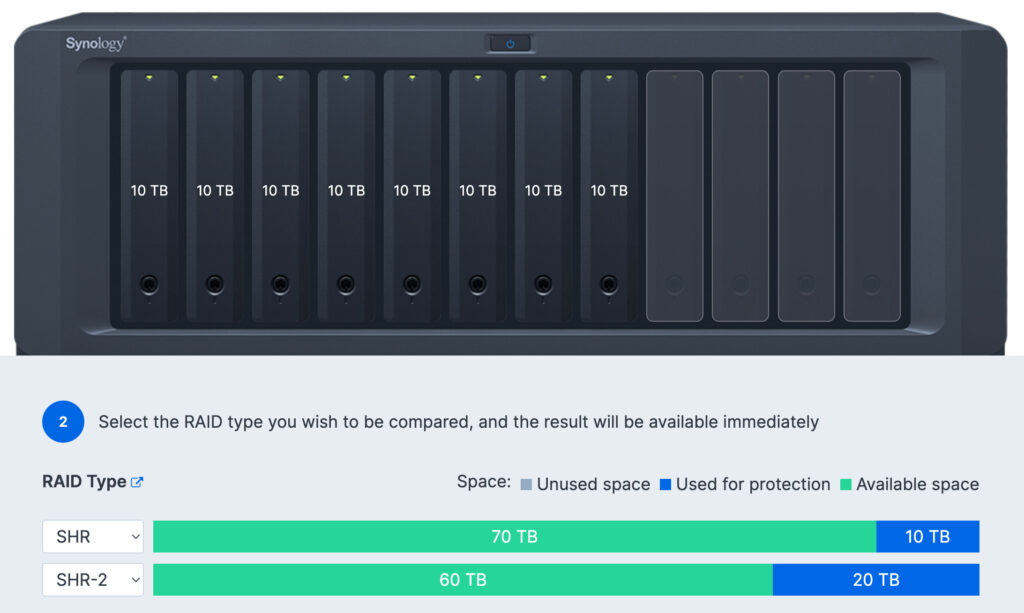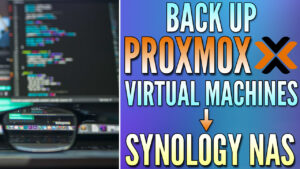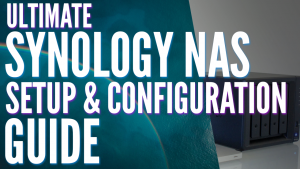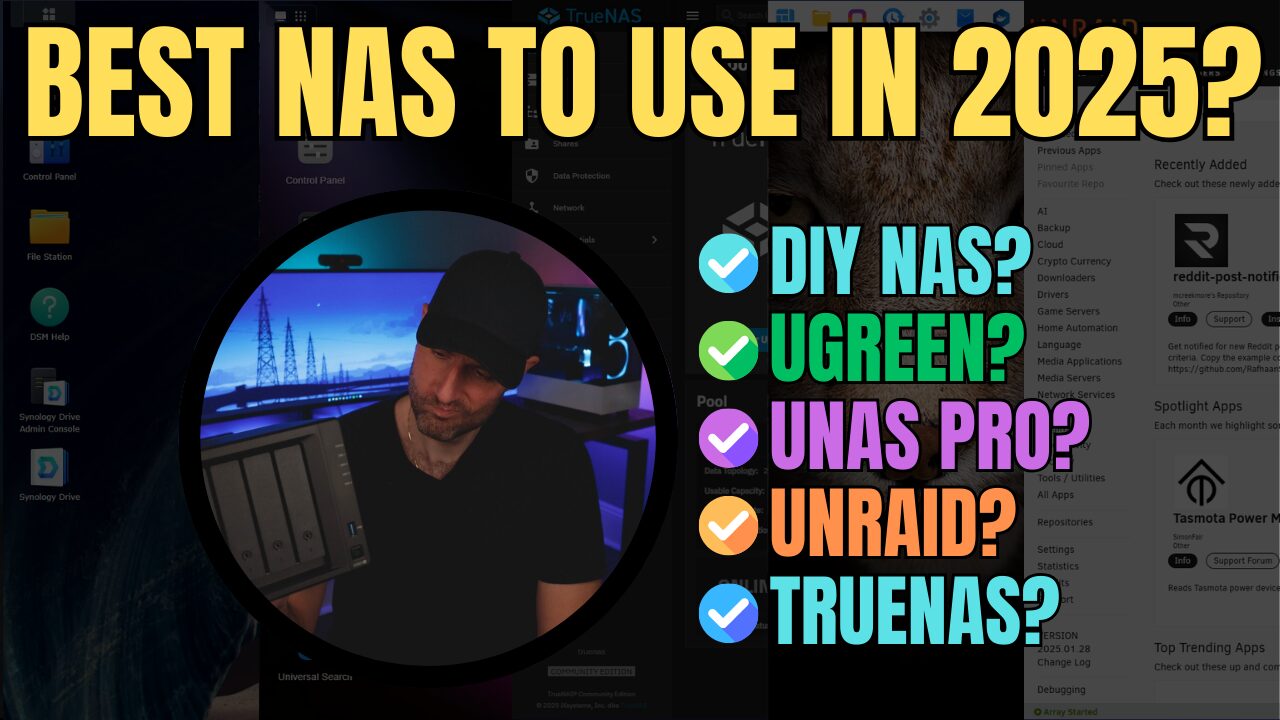In this article, we’re going to look at SHR vs. SHR2 for Synology NAS devices. When you’re configuring a new Synology NAS, the first step is determining which RAID type you’d like to use. Two of the most common options are SHR and SHR2. We’ll compare them, in-depth below to determine the best RAID type you can use.
Introduction to SHR and SHR2
When you’re configuring a new Synology NAS, two great options are SHR (Synology Hybrid RAID) and SHR2. The option that you select will determine the type of RAID configuration you’ll use on your device, and while you can change it in the future (or “upgrade” from SHR to SHR2), selecting the correct option initially is important.
Choosing the right RAID configuration for your Synology NAS can mean the difference between data that’s easily recoverable after a drive failure and data that’s lost forever. The RAID type can also impact your system’s performance and storage efficiency, which is why selecting the correct option is important.
Understanding Synology Hybrid RAID (SHR)
SHR is Synology’s automated RAID management system. Unlike traditional RAID configurations, SHR allows for the use of hard drives of varying sizes without wasting storage capacity. The system dynamically configures the RAID setup to optimize capacity and protection.

Benefits of using SHR
- Flexibility and Efficiency: SHR maximizes storage capability. Even if you mix and match drive sizes, SHR ensures that the maximum space is used. Make sure you plan it out first with Synology’s RAID Calculator to determine the best configuration before committing to a specific option.
- Data Protection: SHR provides one drive’s worth of fault tolerance, allowing for the recovery of data if a drive fails.
- Hard Drive Requirements: Synology Hybrid RAID (SHR) only requires two total hard drives for setup. Therefore, if you’re looking to slowly build your NAS over time (and don’t need three or more hard drives right away), SHR is a great option.
Possible Limitations and Drawbacks of SHR
SHR is not without its limitations. Its major drawback is that it only provides the redundancy of one drive, making it less suitable for environments that require higher data protection. For most people (especially NAS devices with less than five total drive bays), this isn’t really a problem.
However, once you start looking at devices with five or more drive bays, the decision to use more than one drive of redundancy becomes more important.
Exploring Synology Hybrid RAID 2 (SHR2)
SHR2 is an extension of SHR, offering two-drive redundancy. This means that the system can tolerate the failure of two drives simultaneously without any data loss. From a flexibility standpoint, SHR2 shares the same flexibility as SHR (from a mixed drive perspective), but requires four hard drives at minimum.
For this reason, many people start with SHR and eventually “upgrade” to SHR2 when their storage requirements are expanded. Please be aware, however, the upgrade process from SHR to SHR2 can be long and tough on hard drives, so many people prefer starting with SHR2 to mitigate future risks if possible.
Advantages of SHR2
- Higher Data Redundancy: SHR2’s primary advantage is its increased redundancy. With two-drive fault tolerance, it’s ideal for those who need an extra layer of protection.
- Better Data Protection: Along with its higher redundancy, SHR2 ensures that your data remains safe and accessible even in the event of multiple simultaneous hard drive failures.
Disadvantages of SHR2
The trade-off to increased data protection and redundancy is storage capacity. SHR2 requires more of the overall storage for redundancy, meaning you’ll have less usable space than with SHR.
For most people with NAS devices under five total bays, SHR2 doesn’t make much sense unless you truly want the increased redundancy. However, as soon as you get to a point where more than four hard drives are installed in a NAS, SHR2 starts making more sense than SHR.
Comparison of SHR and SHR2
While both SHR and SHR2 offer protection against drive failures, SHR2 provides superior data security by safeguarding against two simultaneous drive failures, whereas SHR only protects against one.
On the other hand, SHR offers more storage space because of this. Therefore, you’ll always have more “usable” storage space when using SHR as opposed to SHR2.

Data Recovery: SHR vs. SHR2
Recovering from a single drive failure is straightforward in both SHR and SHR2. However, if two drives fail simultaneously, SHR2 will protect you, while SHR will not. Please keep in mind that this is for simultaneous drive failures, as both drives must fail at the same time for you to lose data with SHR.
Which Option is Best? SHR or SHR2?
For personal users or small businesses with non-critical data, SHR might be sufficient – especially for NAS devices with less than five drive bays. However, for larger businesses or critical data storage, SHR2’s added protection can be invaluable. From a data protection standpoint, you can compare SHR to RAID 5, and SHR2 to RAID 6.
I continue to highlight this point, but it’s incredibly important to take the total hard drives into consideration. If you’re using an 8-bay NAS device, SHR2 should be considered the minimum, while SHR2 might be overkill for four-bay NAS devices.

Other RAID Alternatives
While you might feel like you need to pick between SHR and SHR2, traditional RAID configurations like RAID 1, 5, 6, and 10 have been around for years, offering varying options to balance performance, data protection, and storage efficiency.
Traditional RAID setups, especially RAID 5 and 6, are the closest comparatives to SHR and SHR2. While these traditional setups are more rigid in their requirements (same-sized hard drives are a requirement or the storage pool will utilize the storage space of the smallest hard drive only).
Choosing the Right Configuration for Your Synology NAS
When you’re picking between SHR and SHR2, or even other traditional RAID types like RAID 1, 5, 6, or 10, you must take into consideration some of these important points:
- Storage Needs: Consider how much data you need to store now and in the future.
- Data Protection Needs: Assess how critical your data is. Do you need the extra protection SHR2 offers?
- Practicality and Efficiency: Think about the balance between protection and storage space.
Knowing the data and how important the potential recovery is should be the overall deciding factor. As always, RAID IS NOT A BACKUP, so ensure that you have proper backups whether you’re using SHR, SHR2, or any other form of RAID.
Conclusion: SHR vs. SHR2
Choosing between SHR and SHR2 is about weighing storage efficiency against data protection. Both offer unique advantages, and the decision should be based on the type of data being stored and how much protection you need. Generally, the total number of hard drives being used should be the biggest indicator of the data protection requirements you’ll need.
For example, using four hard drives and SHR, you’ll have 25% of the drives reserved for data protection. With SHR2 and eight hard drives, you’ll have 25% of the drives reserved for data protection as well, but SHR with eight hard drives will only be 12.5%. The lower the percentage, the higher the risk, so this should always be taken into consideration.
Thanks for checking out the article on SHR vs. SHR2 for Synology NAS devices. If you have any questions on SHR vs. SHR2 for Synology NAS devices, please leave them in the comments!




